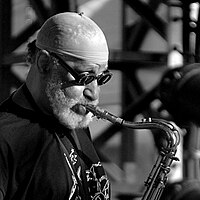Sonny Rollins
[citation needed] After graduating from high school in 1948,[10] Rollins began performing professionally; he made his first recordings in early 1949 as a sideman with the bebop singer Babs Gonzales (trombonist J. J. Johnson was the arranger of the group).
Within the next few months, he began to make a name for himself, recording with Johnson and appearing under the leadership of pianist Bud Powell, alongside trumpeter Fats Navarro and drummer Roy Haynes, on a seminal "hard bop" session.
[11] While there, he volunteered for then-experimental methadone therapy and was able to break his heroin habit, after which he lived for a time in Chicago, briefly rooming with the trumpeter Booker Little.
After the deaths of Brown and the band's pianist, Richie Powell, in a June 1956 automobile accident, Rollins continued playing with Roach and began releasing albums under his own name on Prestige Records, Blue Note, Riverside, and the Los Angeles label Contemporary.
His widely acclaimed album Saxophone Colossus was recorded on June 22, 1956, at Rudy Van Gelder's studio in New Jersey, with Tommy Flanagan on piano, former Jazz Messengers bassist Doug Watkins, and his favorite drummer, Roach.
[citation needed] In 1956, he recorded Tenor Madness, using Davis's group – pianist Red Garland, bassist Paul Chambers, and drummer Philly Joe Jones.
Rollins used the trio format intermittently throughout his career, sometimes taking the unusual step of using his sax as a rhythm section instrument during bass and drum solos.
[20] In 1957, he made his Carnegie Hall debut[21] and recorded again for Blue Note with Johnson on trombone, Horace Silver or Monk on piano and drummer Art Blakey (released as Sonny Rollins, Volume Two).
"[23] The title track is a nineteen-minute improvised bluesy suite; the other side of the album features hard bop workouts of popular show tunes.
[25] While living on the Lower East Side of Manhattan, he ventured to the pedestrian walkway of the Williamsburg Bridge to practice, in order to avoid disturbing a neighboring expectant mother.
[30] In the summer of 1961, the journalist Ralph Berton happened to pass by the saxophonist on the bridge one day and published an article in Metronome magazine about the occurrence.
Produced by George Avakian, the disc was recorded with a quartet featuring guitarist Jim Hall, Ben Riley on drums, and bassist Bob Cranshaw.
On the album Our Man in Jazz, recorded live at The Village Gate, he explored avant-garde playing with a quartet that featured Cranshaw on bass, Billy Higgins on drums and Don Cherry on cornet.
[39] In 2007, recordings from a 1965 residency at Ronnie Scott's Jazz Club were released by the Harkit label as Live in London; they offer a very different picture of Rollins's playing from the studio albums of the period.
After East Broadway Run Down (1966), which featured trumpeter Freddie Hubbard, bassist Jimmy Garrison, and drummer Elvin Jones, Rollins did not release another studio album for six years.
During this hiatus period, he visited Jamaica for the first time and spent several months studying yoga, meditation, and Eastern philosophies at an ashram in Powai, India, a district of Mumbai.
[43] Reviewing a March 1972 performance at New York's Village Vanguard night club, The New Yorker critic Whitney Balliett wrote that Rollins "had changed again.
In 1974, Rollins added jazz bagpiper Rufus Harley to his band;[47] the group was filmed performing live at Ronnie Scott's in London.
[50] In June of that year he joined many other major jazz artists in a performance for President Jimmy Carter on the South Lawn of the White House.
[53] He also frequently played long, extemporaneous unaccompanied cadenzas during performances with his band; a prime example is his introduction to the tune "Autumn Nocturne" on the 1978 album Don't Stop the Carnival.
[54] By the 1980s, Rollins had stopped playing small nightclubs and was appearing mainly in concert halls or outdoor arenas; through the late 1990s he occasionally performed at large New York rock clubs such as Tramps and The Bottom Line.
He added (uncredited) sax improvisations to three tracks by the Rolling Stones for their 1981 album Tattoo You, including the single, "Waiting on a Friend"[55] and the long jam "Slave".
[61] Several days later, Rollins gave a performance at New York City's Beacon Theatre that reunited him with musicians with whom he played as a teenager, including McLean, Walter Bishop Jr., Percy Heath, Connie Henry, and Gil Coggins.
[65] On September 11, 2001, the 71-year-old Rollins, who lived several blocks away, heard the World Trade Center collapse, and was forced to evacuate his Greenwich Street apartment,[66] with only his saxophone in hand.
The band that year featured his nephew, trombonist Clifton Anderson, and included bassist Cranshaw, pianist Stephen Scott, percussionist Kimati Dinizulu, and drummer Perry Wilson.
During these years, Rollins regularly toured worldwide, playing major venues throughout Europe, South America, the Far East, and Australasia; he is estimated to have sometimes earned as much as $100,000 per performance.
2 (with four tracks documenting his 80th birthday concert, which included Rollins's first ever recorded appearance with Ornette Coleman on the twenty-minute "Sonnymoon for Two"); Road Shows, Vol.
[80] That spring, he made a guest television appearance on The Simpsons in "Whiskey Business"[81] and received an honorary Doctor of Music degree from the Juilliard School in New York City.
[85][86][87] Later that year, he endowed the "Sonny Rollins Jazz Ensemble Fund" at Oberlin College, in "recognition of the institution's long legacy of access and social justice advocacy.
The German critic Joachim-Ernst Berendt described this tradition as sitting between the two poles of the strong sonority of Coleman Hawkins and the light flexible phrasing of Lester Young, which did so much to inspire the fleet improvisation of bebop in the 1950s.




